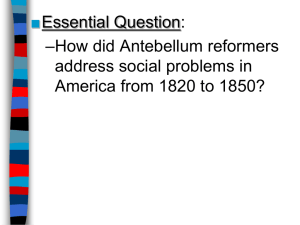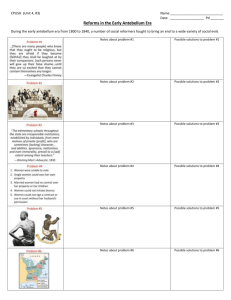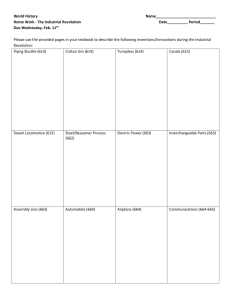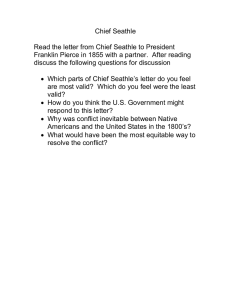■ Essential Question: –How did reformers try to address social
advertisement
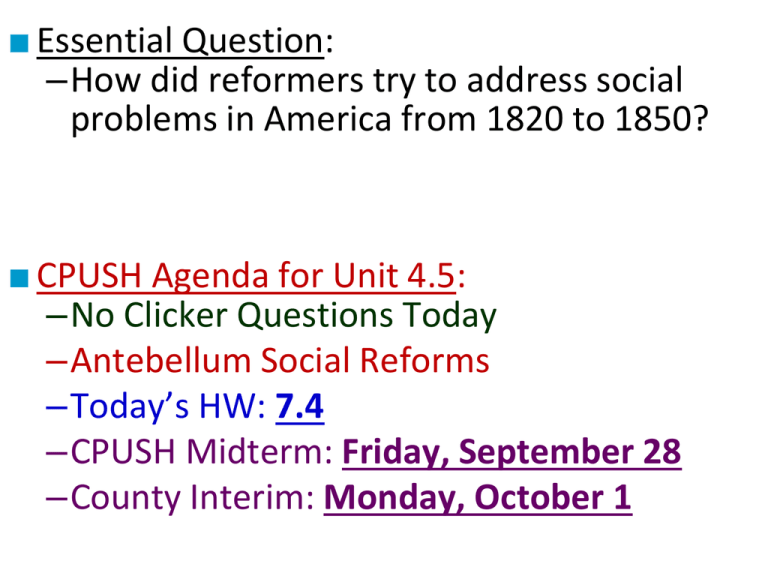
■ Essential Question: –How did reformers try to address social problems in America from 1820 to 1850? ■ CPUSH Agenda for Unit 4.5: –No Clicker Questions Today –Antebellum Social Reforms –Today’s HW: 7.4 –CPUSH Midterm: Friday, September 28 –County Interim: Monday, October 1 Antebellum Reforms During the early antebellum era from 1800 to 1840, a number of social reformers fought to bring an end to a wide variety of social evils Antebellum Reforms Activity Directions ■ What were the social problems and reform movements of the antebellum era? –Working with your partner, examine the placard and guess what the antebellum problems was –When you have made your guess, turn the card over and take brief notes on your chart –As a team, come up with a specific solution you think antebellum reformers might have used to try to solve the problem Problem #1 …[There are many people] who know that they ought to be religious, but they are afraid if they become [faithful] they shall be laughed at by their companions. Such persons never will give up their false shame…until they are so excited that they cannot contain themselves any longer. —Evangelist Charles Finney By 1800, church membership in was low and falling; Just 1 out of 15 people in America was a member of a church Poverty, crime, and immorality seemed to be increasing at an alarming rate From 1800 to the 1830s, a series of religious revivals swept across America called the Second Great Awakening Evangelical ministers like Charles Finney used emotional, soul-shaking sermons to convert the masses When the church finds its members falling into gross and scandalous sins, then it is time for the church to awake and cry to God for a Revival of Religion. Revivals involved highly emotional “camp meetings” with thousands of people in attendance The Second Great Awakening had an important impact on American history By 1850, 1 in 6 Americans was a member of a church Joseph Smith created the Mormon Church New utopian communities were created as many people wanted to live Devout Christians were committed to reforming society The angel Moroni presents Joseph Smith gold tablets that became the Book of Mormon Problem #2 By 1800, alcohol abuse was seen as a serious problem Whiskey By 1820, the typical adult Alcohol was was cheap drank more than 7 gallons linked to crime, to make of alcohol per year debt, abuse, and buy (Today, its 2.6 gallons) work problems One of the first reform movements was to get people to stop drinking called temperance Reformers convinced people to make a “pledge” to not drink The Women’s Christian Temperance Union (WCTU) played an important role in the temperance movement From 1820 to 1830, drinking fell from 7 gallons per person per year to 3 gallons Problem #3 “The elementary schools throughout the state are irresponsible institutions, established by individuals, from mere motives of private [profit], who are sometimes [lacking] character… and abilities. Ignorance, inattention, and even immorality, prevail to a [sad] extent among their teachers.” —Working Man's Advocate, 1830 By 1800, the U.S. did not Massachusetts and Vermont have a true education were the only states with system for children compulsory attendance laws In most states, classes Few children attended school were not divided by age past the age of 10 years old Education reformers Horace Mann helped demanded that states create create teacher-training public schools for children and curriculum programs By 1850, every state had publically-funded schools (but schools in the South and West were not very good) Problem #4 1. Women were unable to vote 2. Single women could own her own property 3. Married women had no control over her property or her children 4. Women could not initiate divorce 5. Women could not sign a contract or sue in court without her husband’s permission Women’s opportunities were limited by the cult of domesticity Women were expected to oversee the family and home while their husbands worked to provide money Married women had no property rights and could not file for divorce Women could not vote, run for political office, or sue in court In 1848, Elizabeth Cady Stanton organized the first women’s rights meeting, the Seneca Falls Convention The convention produced the Declaration of Sentiments, a list of demands including property rights for women and the right to vote This meeting was important, but failed to gain any major goals of the women’s rights movement “We hold these truths to be self-evident that all men AND WOMEN are created equal” “The history of mankind is a history of repeated injuries on the part of men toward women, having in direct object the establishment of an absolute tyranny over her.” Problem #5 “King Cotton” led to a huge growth in the African slave population Northerners began to see slavery as immoral By the 1830s, all Northern states abolished slavery Slave rebellions and escape through the Underground Railroad became more common In the 1830s, abolitionism (the desire to emancipate all slaves) grew radical Abolition grew more popular in the North, but was seen as a threat to the “Southern way of life” In the 1830s, abolitionism (the desire to emancipate all slaves) grew radical Abolition grew more popular in the North, but was seen as a threat to the “Southern way of life” William Lloyd Garrison was America’s leading abolitionist His American Anti-Slave Society and The Liberator newsletter demanded the immediate end to slavery without payment to slave owners Frederick Douglass was a runaway slave, popular anti-slavery speaker, and author of the North Star newsletter Problem #6 State requirements to vote in elections Before 1800, America was not very democratic Most states restricted voting to rich, white men by requiring property and tax qualifications As a result, less than 50% of white men could vote by 1800 State requirements to vote in elections From 1800 to 1840, democracy increased in America By 1840, most states removed voting restrictions As a result, 90% of “common” white men could vote (“universal white male suffrage”) State requirements to vote in elections Reviewing Key Themes
